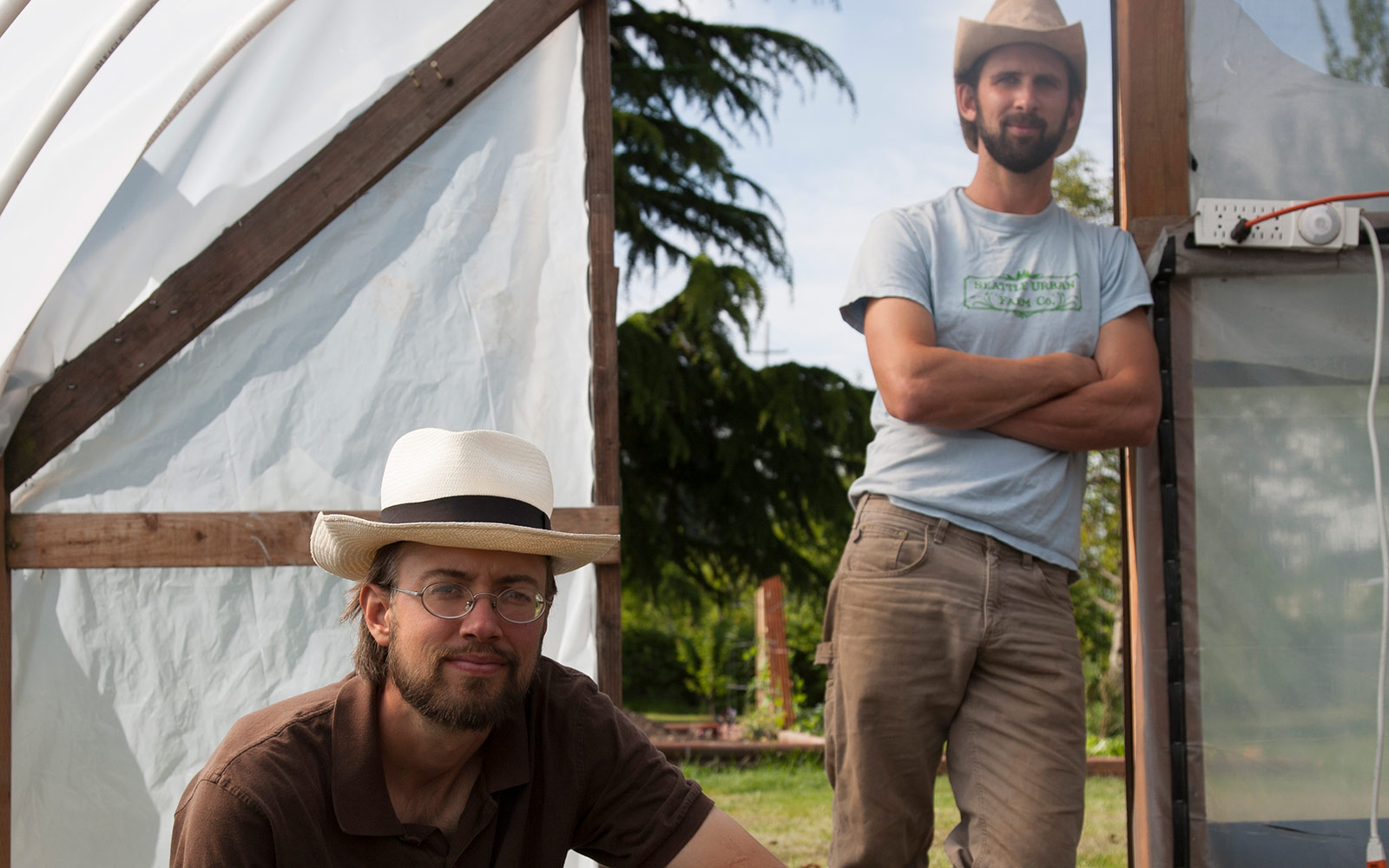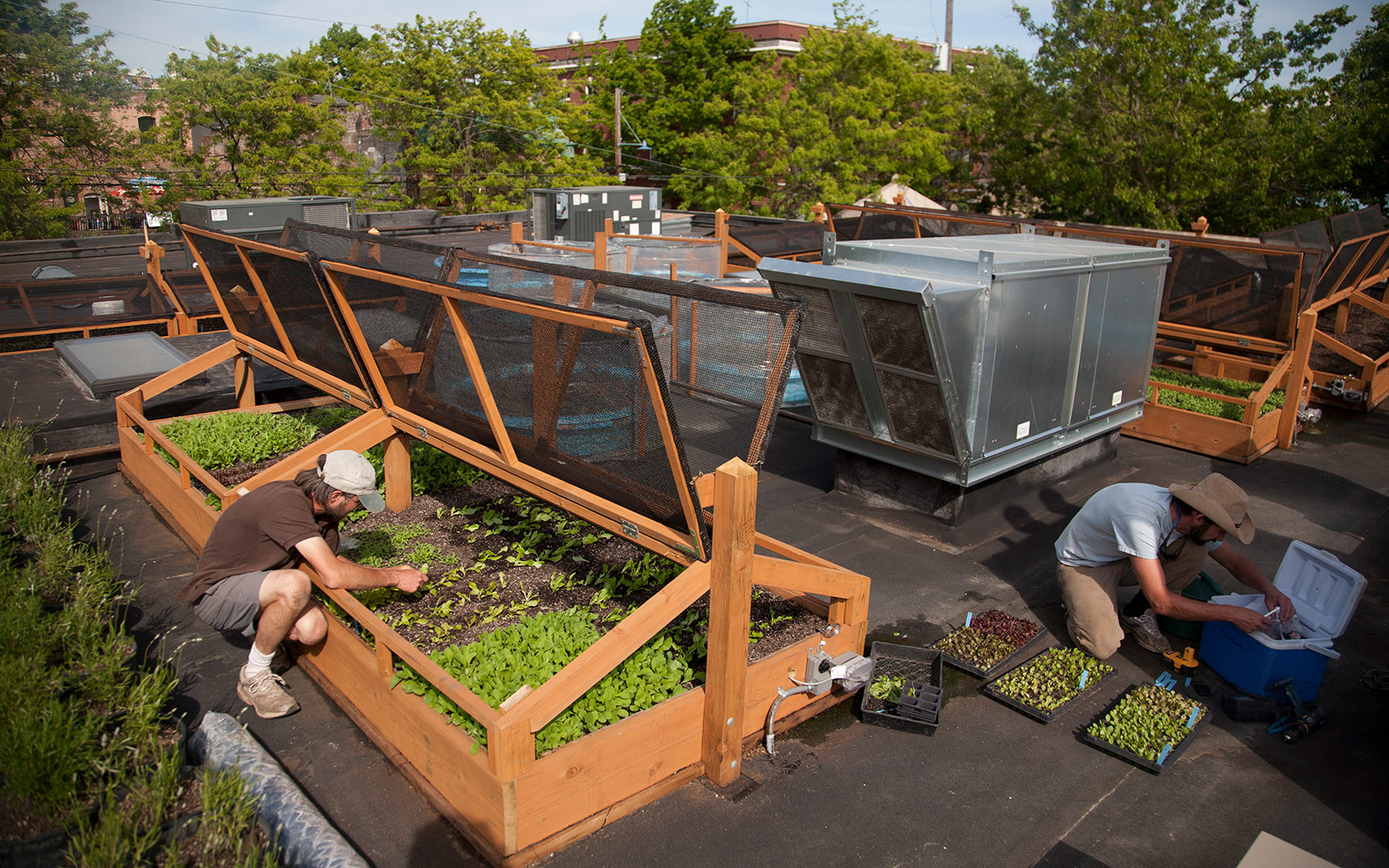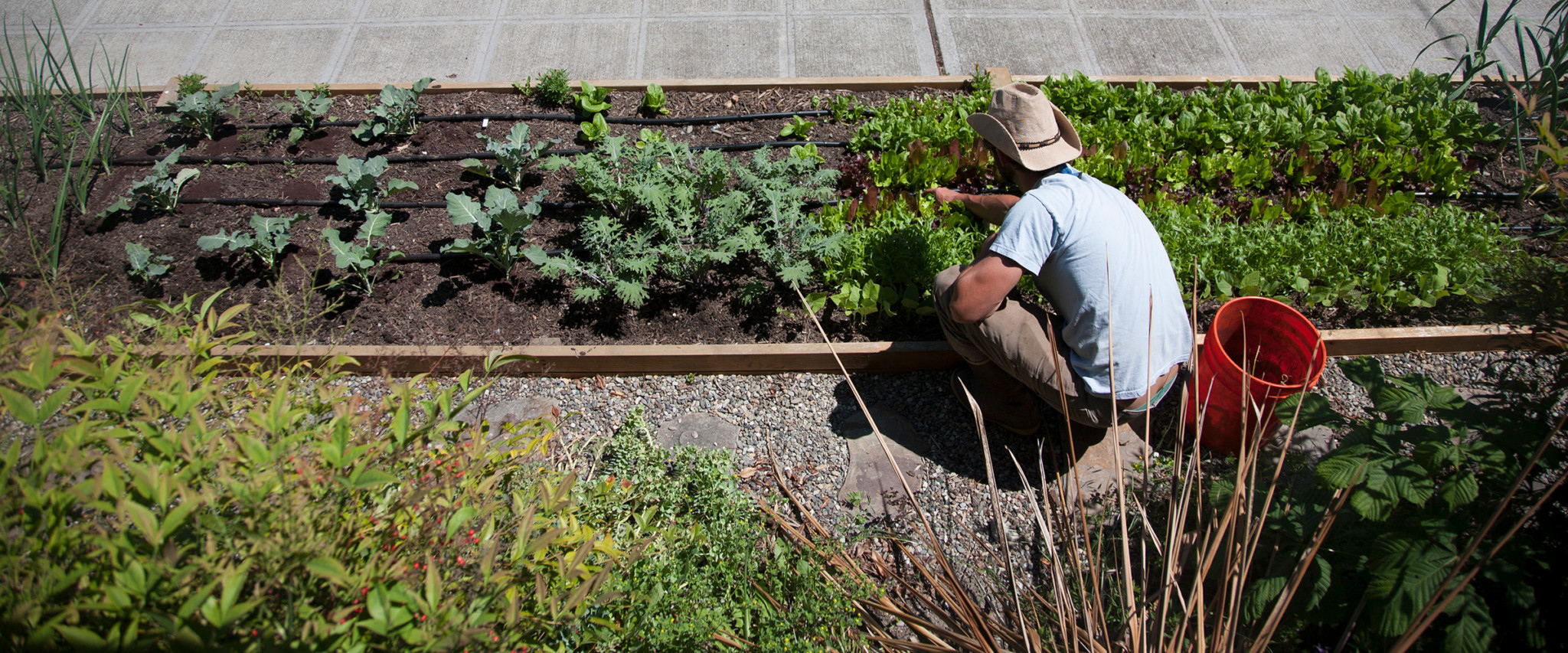The first time I see Colin McCrate '00, he is holding a turnip roughly the size of his head. It is a portrait of awkward pride. Awkward because most people have little interest in turnips–not even if it's big enough to take over their homes–and McCrate isn't the type to proselytize. Still, I can tell he's secretly dying to explain why this turnip is so special.
The story goes like this: A man McCrate met in Costa Rica recounted to him the legend of a behemoth heirloom turnip grown during his grandmother's youth. This was a turnip fit for the Guinness Book of World Records, yet no seed company or seed-saving organization had any record of its seeds, making its existence even more mythical. Then, one day, the man found a jar of the seeds sitting on a windowsill in his grandmother's house. Miraculously, the seeds were still viable. Even better, the man believed in sharing.
That was just the beginning.
As owner of Seattle Urban Farm Company (SUFC)–a business whose primary aim is to create sustainable backyard landscapes–countless fruits, vegetables, and seeds have passed through McCrate’s hands. I am here on this quiet Thursday afternoon at one of SUFC’s sites–a modest one-story home in a middle-class neighborhood a few miles from the Space Needle–to learn how to plant onions, potatoes, and peas in a plot of land no bigger than a plastic baby pool. But McCrate and his business partner, Brad Halm ‘02, are here to teach me something beyond the basics. They want me to recognize the value of connecting with food in a more personal way–”It sort of makes eating a whole new experience when you know where your food comes from,” says Halm. That’s the lesson they bring to all their clients, even those who live smack dab in the middle of skyscrapers and ceaseless traffic. Turns out, it doesn’t matter who you are or where you live. Everyone has the power to make something grow.
I am a bit skeptical, however, because I can’t even grow weeds. The SUFC boys, who have won awards for transforming green spaces by installing ready-to-go vegetable gardens complete with clean soil, drip irrigation, and raised beds, can sense my hesitation. “I just don’t understand how something so small can turn into this brilliant, vital thing,” I say, looking down at the fragile stalk of green onion in my hand. McCrate smiles. He knows how.
He knows that the onion starts out weak, its verdant arms spindly and limp, but its roots are strong. It grabs hold of the soil with a dogged ferocity, pushing itself to become something more.
It’s not unlike the shriveled pea he hands me later, which reminds me of a tiny green pearl. We bury dozens of them in the cold ground, along with a few pea plants the size of pencils, and McCrate says they will soon claw their way up the trellis he has installed, forming a beautiful curtain across the sky.
Although McCrate knew he wanted to be a part of something bigger than himself, the idea of growing food as a livelihood took some time to germinate. After spending much of his time at Denison on the Homestead, graduating with a degree in environmental science, he spent several years teaching himself about gardening before getting his hands dirty on a day-today basis. It was an opportunity to manage a garden in an environmental education center on Orcas Island that brought him to the West Coast. He was hooked from that point forward–on Washington state, and on gardening. He eventually moved to Poulsbo, just outside Seattle, and worked on an organic farm, where he honed his skills.
Somewhere along his journey, he got it into his head that it would be a good idea to help people build gardens in their backyards–even backyards in the heart of the city–but it seemed no one was interested in his ideas. In fact, when he mentioned it to his co-workers, they said no one would ever pay for such a service. Still, he decided to take a chance on his dreams and launched SUFC in January of 2007.
“When I decided to start the company, I didn’t have anything to base it on,” McCrate admits. “I couldn’t find any other examples of people doing what I wanted to be doing, so I couldn’t find anyone willing to go along with the idea. But then I called Brad, and was able to convince him to give this a shot.”
Halm, who had been managing a community-supported agriculture program in Mifflintown, Pa., didn’t need much convincing. “I thought Colin had a really good idea,” he says, “I liked the idea of growing food in the city.” So Halm moved to Washington, McCrate quit the landscaping job he had at the time, and the two dove right in.
Today, in that tiny backyard garden, it’s Halm’s turn to educate me on the ways of the tuber. He places several varieties of quartered potatoes in front of me.
“Make sure you keep enough room between them,” he says, moving the wedges across the soil like checkers. “And don’t put them all in a single row. It’s best to alternate their location.”
I don’t see how any of this would matter. Then he tells me about their eyes. He explains how the tiny tubers can see through all that dirt and, like black, silty fireworks, begin to sprout, pushing through the deep belly of the earth out into the light. Potatoes, it seems, can still find their destiny, even in the darkness.
If potatoes can find their way out of the darkness, surely we can, too. At least that’s what Halm and McCrate hope, and it’s part of the reason they do what they do. Though most Americans are tempted by the easy way out–grabbing a bucket of chicken from the drive-through after work or tossing something unrecognizable into the microwave–McCrate and Halm contend that it’s even easier to implement subtle changes in our daily lives that can profoundly affect our direct environment. McCrate and Halm encourage their clients to think about what they can do with the resources available to them. If given the choice, would you get the local, organic milk that’s a bit more expensive, or the antibiotic-laced, factory-farmed milk that’s on sale? Will you pass the farmers market on the way to the grocery chain because there’s better parking closer to the door? Change is all about choice, and if Americans reconsidered some of our simplest choices, the SUFC boys argue, we could make a difference.

The benefits are staggering, and people’s growing awareness seems even more so, with books like Michael Pollan’s The Omnivore’s Dilemma and Barbara Kingsolver’s Animal, Vegetable, Miracle, contributing to the new crop of locavores–people who base their diet upon the food available to them locally. Beyond eliminating the middle man (the factory farms that produce most of the food we eat), growing our own food or eating locally grown food is cheaper and allows us to eliminate or significantly reduce food packaging, pesticides and other detrimental chemicals, along with the weeks and miles (three and 1,500 on average, respectively) required to transport most produce to our supermarkets and, ultimately, our plates. One of the greatest benefits, says McCrate, comes from knowing you’re nurturing your local ecology, eating food right after it’s picked and making conscious choices about what goes into your body.
“I don’t think anyone thought it was a bad idea to grow your own food 10 years ago,” says McCrate, “but it wasn’t in their consciousness as much as it seems to be now.”
He is hopeful that people who grow their own food will develop a different kind of connectivity that will inform their other consumer choices.
“You soon realize you can’t buy half your groceries in a traditional grocery store and grow the other half,” he says. “You go to farmers’ markets instead. That’s how it worked for me. I became much more aware of how I was eating and what I was putting in my body.”
McCrate seems to be pretty comfortable in that body as he arcs over a blanket of lettuces. His hands are tattooed in dirt, and when he reaches a tanned arm forward to lift his cowboy hat, I catch a glimpse of black, tousled hair and blue eyes. He looks like a farmer. Halm, whose hands are chiseled and strong, dons a baseball cap in lieu of the cowboy look. He is tall and lanky with dirty blond hair that peeks out from under his hat. There is depth behind his spectacled eyes, and a quiet sensitivity about the way he approaches things, whether it’s his careful attention to detail (like how far apart to plant potatoes) or the way he explains how life on the Homestead gave him the knowledge and confidence to pursue a career in farming.
His clients rely on that knowledge to make better choices. After all, he and McCrate don’t remove the responsibility just because they’re the ones with the wheelbarrows. Their services are rooted firmly in education.
“I don’t think I got into this line of work because I wanted to do people’s gardening for them,” admits Halm. “I wanted to see people getting excited about food on their own. Thankfully, the majority of people who are attracted to what we do develop a personal connection to their garden once they see it take shape.”
People like William, the five-year-old son of clients, who simply could not contain his enthusiasm for the tomatoes growing in his backyard. William, it seemed, was so fascinated by the plants that his parents had to drag him out of the garden each morning. Armed with a basket and a dimpled smile, he was fully prepared to pick the green fruit. He didn’t yet understand that when they were green it meant they weren’t ready.
“Once I explained that tomatoes need time to grow, and start to blush as they ripen, he totally understood,” says McCrate. “But you can be sure he was right there to announce the arrival of the first ripe tomato.”
Seeing his littlest client’s burgeoning passion is inspiring to McCrate, who doesn’t want people to like urban farming because they think it’s the next big thing. And he certainly doesn’t want people to jump on the bandwagon because everyone in their neighborhood is doing it.

Though the Seattle Urban Farm Company has been doing backyard gardens in and around the city since it’s opening in 2007, the crew has recently taken on projects for schools and local restaurants, including
a garden on the roof of Bastille, a new French restaurant in Seattle.
He does what he does because he believes in it. Anyone who does this kind of work has to. Farming, whether in a backyard or in a field, is hard work. It’s back-breaking, and often thankless. It’s not something you do if you want to become famous. (Though, in a fortuitous twist of fate, McCrate was photographed for the May issue of GQ to illustrate the quintessential backyard farmer and he made it to number 14 on a suggested list of farmers nominated to transform five acres of the White House lawn into an organic fruit and vegetable garden.)
“In the past, an article about what we’re doing has gotten us a giant flush of people, but this year, most of the people who call us have been recommended by existing clients,” McCrate says. “It’s cool when that happens. It means people think we’re doing an okay job.”
Farming–whether in a backyard, in a community garden, or by sharing in the harvest of local farmers through a community supported agriculture program– is definitely growing in popularity these days. Take that contest to become the White House gardener: 56,000 people cast their votes online. And according to a Time article published last year, sales of vegetable seeds have soared, overtaking flowers for the first time since the 1950s. School districts across the nation are offering local food in their cafeterias (often grown by students), and universities with nutrition and food programs are now providing food grown on campus to students, faculty, and staff. In fact, McCrate and Halm have been contacted by a few local elementary schools, where some of their clients serve as teachers. There is talk about building both gardens and indoor greenhouses, where curriculum could be tailored to help students connect with food in new ways.
Farmers’ markets are sprouting at a rapid pace, and urban farming is gaining speed as people who are busy, intimidated, or just a little lazy begin to realize the importance of playing an active role in their own food production. This applies to homeowners with lots of space, to city dwellers in high-rise apartments, where space is at a premium. As far as McCrate is concerned, no job is too big or too small. To prove it, he installed a garden complete with an irrigation system on the balcony of a condo in the heart of downtown Seattle.
On a slightly bigger scale, SUFC installed a rooftop garden teeming with lettuces and herbs at a French restaurant in Ballard, a funky Seattle neighborhood noted for its food scene. “I’d love to be doing more school gardens, restaurants and work with the city on some of their projects,” says McCrate. “I really think things will be moving in that direction soon.”
McCrate’s projections seem realistic, given that his phone has been ringing off the hook since the day SUFC first opened its doors. “It’s a little scary how busy we are,” he says. “We’re booked up for months, and have hired more staff to keep up with all the work.”
That the men of SUFC are busy is a good thing, and is a tremendous statement about our growing awareness of sustainable food sources. But Seattle is just a small patch of our big nation. And although cities such as San Francisco, Portland, and New York are all sporting similar urban farming ventures, there’s room to grow.
It all goes back to the idea that big things come from small beginnings. That’s how a giant turnip–and everything in-between–got into Colin McCrate’s hands. What began as a quest for discovery, morphed into a commitment to cultivating the future. As I cover the last pea with a handful of soil, I realize it’s not as difficult as we think. All it takes is one person to plant the seed.
Stefanie Ellis is a freelance writer in Seattle, Wash.
More internship opportunities are available for next year. Seasons run April through August. But just as you’d expect, every great education comes with a lot of hard work. SUFC puts out the following disclaimer: “The work can be physically demanding. During the height of the garden installation season, days are long and feel much longer. Expect to carry heavy loads and get very dirty. The work is enjoyable, but the physical aspect should not be underestimated.” If interested, contact McCrate at (206) 816 -9740 or colin@seattleurbanfarmco.com

Radish Greens Soup
Halm, who enjoys finding unique ways of using his harvest, has shared a recipe that highlights spring radishes and uses up the last of your storage potatoes.
- 1 tablespoon butter
- 3 cups chopped radish greens (turnip greens or kale also work well)
- 4 cups water or broth
- 2 large potatoes, cubed
- 12 radishes, thinly sliced
- 1 tablespoon cider vinegar
- salt and pepper to taste
- 1 tablespoon Dijon mustard
- 1/3 cup sour cream
- grated cheese
- Melt butter in soup pot over medium heat. Toss greens for one minute in the hot butter. Add water or stock and bring to a boil. Add potatoes and simmer 25-30 minutes or until tender. Puree in a blender.
- Meanwhile, place radishes and vinegar in soup pot. Add enough water to cover, bring to a boil and simmer for three to four minutes. Drain remaining liquid and add to pureed soup.
- Mix mustard and sour cream in a small bowl. Add two ladles of soup to bowl, mix, and then whisk mixture back into soup.
- Add salt and pepper to taste, and garnish with grated cheese.

5 Ways to manage Your Own Urban Farm
Offer Laying Hens a Home
Chicken don’t need much space, require less management than most household pets, and are fun to observe. The first time you eat an egg from your own hen, you’ll wonder why you haven’t had a flock in the yard your whole life.
Grow Your Own Salad
Anyone can raise a quick crop of lettuce or arugula on a sunny porch, balcony, or windowsill. Fill a planting flat with potting soil, mix in a little organic fertilizer, slide seeds into the top ½ inch of soil, and keep it watered. You’ll be eating fresh salad in a month.
Add Trees to Your Landscape
Fruit trees are beautiful when in flower, and can produce huge amounts of food for eating fresh and preserving. If you choose a type well-suited to your region, your maintenance and pest problems should be minimal.
Invite Some Worms to a Meal
Vermicomposting (worm composting) is an easy way to recycle your kitchen scraps and through the, um, digestive process of worms, turn them into garden fertilizer. Despite what you may initially think, worms are odor free, easy to manage and make for fun conversation at dinner parties.
Hit the Farmer’s Market
This is a great way to buy all of those crops you don’t have room for at home from a local source. It is also a great way to learn what is in season, what crops grow well in your area and meet some of the coolest people in town.

